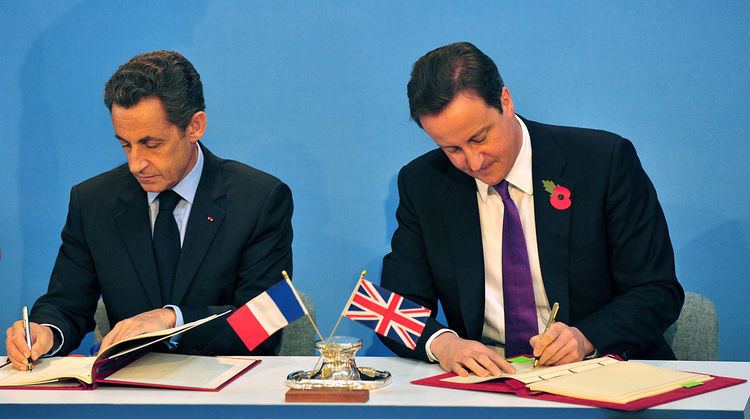Type Defence treaties Location London, England | Signed 2 November 2010 Parties France, United Kingdom | |
 | ||
The Lancaster House Treaties of 2010 are two treaties between the United Kingdom and France for defence and security cooperation. They were signed at 10 Downing Street on 2 November 2010 by British Prime Minister David Cameron and French President Nicolas Sarkozy.
Contents
Downing Street Declaration
The 2 November 2010 Downing Street declaration by President Sarkozy and Prime Minister Cameron. The elements of this declaration are as follows.
Combined Joint Expeditionary Force
It was decided to develop a Combined Joint Expeditionary Force (CJEF) suitable for a wide range of scenarios, up to and including high intensity operations. It will involve all three armed Services: there will be a land component composed of formations at national brigade level, maritime and air components with their associated Headquarters, and logistics and support functions. It will not involve standing forces but will be available at notice for bilateral, NATO, European Union, United Nations or other operations. It will begin with combined air and land exercises during 2011 and will develop the concept before the next UK-France Summit and progress towards full capability in subsequent years. The Force is intended to stimulate greater interoperability and coherence in military doctrine, training and equipment requirements.
Aircraft carriers
The UK had earlier announced its decision to install catapults and arresting gear on its new aircraft carriers (currently under construction) which French aircraft would be capable of using, creating opportunities for UK and French aircraft to operate off carriers from both countries. Building primarily on maritime task group co-operation around the French carrier Charles de Gaulle, the UK and France would have aimed to have, by the early 2020s, the ability to deploy a UK-French integrated carrier strike group incorporating assets owned by both countries. This was to ensure that the Royal Navy and the French Navy would work in the closest co-ordination. The decision to install the catapults and arresting gear was later reversed.
Equipment and capabilities
They agreed cooperation in the following areas.
Counter-terrorism
To develop co-operation in the following areas:
International security
France and UK agreed that they would pursue closer co-operation across the board between NATO and the EU, and a lasting partnership between NATO and Russia based on practical co-operation and reciprocity.
34th Franco-British Summit
A follow up meeting occurred on 3 March 2016, with further pledges on counter terrorism, military defence, civil nuclear work and migration.
Relationship to European Union Defence Policy
The treaty is bilateral between the UK and France and does not have a formal link with the European Union’s Common Security and Defence Policy. It does not use the separate Lisbon Treaty’s Permanent Structured Cooperation facility, nor involve the European Defence Agency.
